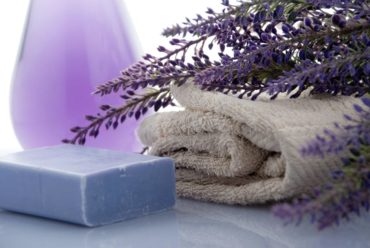 We all know that healthy living means things like eating healthy food, getting enough sleep and exercise, shedding stress and living in a clean, healthy home. However, even in seemingly clean, well-kept homes, “indoor air can be deadlier than outside air.” The culprit? “Smoke, fungal spores, and chemicals used in certain paints, varnishes, and cleaners.”
We all know that healthy living means things like eating healthy food, getting enough sleep and exercise, shedding stress and living in a clean, healthy home. However, even in seemingly clean, well-kept homes, “indoor air can be deadlier than outside air.” The culprit? “Smoke, fungal spores, and chemicals used in certain paints, varnishes, and cleaners.”
In other words, the very cleaners we rely on to create a clean environment are instead making us sicker. This is what’s behind the resolution of many people to try to reduce the amount of chemicals in the foods we eat and in our houses with our cleaning products.
The Centers for Disease Control and Prevention, in its Household Cleaning section, recommends using bleach on your household surfaces. Bleach! Right after this advice, the CDC reminds us not to mix bleach with any other cleaner, to wear rubber gloves and eye protection, and to try not to breathe in the fumes. Those are a lot of warnings for a product we are purposefully putting in our house.
You know how important it is to keep your house clean, but what products to use has been the cause of recent debate. Before we discuss the pros and cons of different cleaning products, it is important to realize that although this debate may be frustrating, finding a way to keep your house clean is a must.
Skip a few weeks, and you can see the mold and mildew growing on your shower curtains and walls. If soap scum builds up enough, you may see a pink colored bacterium, called Serratia Marcescens, breeding. That’s just what you can see; most germs are not visible to the naked eye.
Gastrointestinal viruses and respiratory problems are just a few illnesses that may be caused by not keeping your house clean. Not cleaning your house can make you sick, but some of the chemicals in our cleaning products can result in health problems, too.
 According to the American Lung Association, “Some products release dangerous chemicals, including volatile organic compounds (VOCs). Other harmful ingredients include ammonia and bleach. Even natural fragrances such as citrus can react to produce dangerous pollutants indoors.” The same article goes on to report that cleaning supplies have caused health problems such as respiratory illnesses, allergic reactions, headaches and even cancer, although the most common and immediate concerns include irritation of the eyes, throat and skin.
According to the American Lung Association, “Some products release dangerous chemicals, including volatile organic compounds (VOCs). Other harmful ingredients include ammonia and bleach. Even natural fragrances such as citrus can react to produce dangerous pollutants indoors.” The same article goes on to report that cleaning supplies have caused health problems such as respiratory illnesses, allergic reactions, headaches and even cancer, although the most common and immediate concerns include irritation of the eyes, throat and skin.
How then do you clean, but keep yourself and family safe?
Step one: Know what’s in the cleaners you use.
Read labels on all cleaning supplies before you buy them. Cleaning supplies are not regulated, so you need to do the work yourself. A product may claim that the amount of a harmful substance in it is too low to harm you, but most of us clean several parts of our house in one day: floors, sinks, ovens, counters, toilets, bathtubs, windows — and the list goes on.
If each product you use has a small amount of a harmful substance in it and you use five different cleaners in one day, the amount of toxins you breathe, touch and smell can increase to more dangerous levels.
Step two: Choose cleaning products with less of the bad stuff.
The U.S. Environmental Protection Agency has a list of products that meet its requirements for both performing and being safer for human health and the environment. They are called “Safer Choice Certified,” and include not only all-purpose cleaners, but car care products, dish soaps, floor cleaners, laundry products and tub and tile cleaners.
Step three: Avoid chemicals by using natural cleaners.
Choose natural cleaning products but remember the word “natural” is not federally regulated and can be used loosely.
Step four: Make your own cleaning products.
If you have the time, you can ensure you know what’s in your cleaning products by making your own. Check out these easy and economical recipes.
Step five: Choose cleaning products by rating.
The Environmental Working Group rates cleaning products. See its reviews here.
Here are a few products that received an A rating on the EWG’s Guide to Healthy Cleaners:
- Mold control — Concrobium Mold Control by Planet People
- Tub or shower — Arm & Hammer Pure Baking Soda
- Surfaces — AspenClean All Purpose Cleaner
- Windows — Attitude Window & Mirror Eco Cleaner
If you would rather avoid any chance of chemicals, you may want to clean with a product like Norwex. Norwex claims to reduce chemicals because its dense microfiber cleaning cloths and mops use nothing but water.
The choice of what products to use in your home is a personal one. If someone in your family has asthma or a compromised immune system, this choice may be even more important to you.
Hopefully, this article got you thinking about how healthy your home environment is. Research the products you currently use. If their ingredients or ratings shock you, explore other options.
As you can see, there are many views on how to best clean your home. Knowing the options available to you and what’s in the products you currently use are the best methods for determining the optimum method of cleaning your house while keeping your family safe.
























